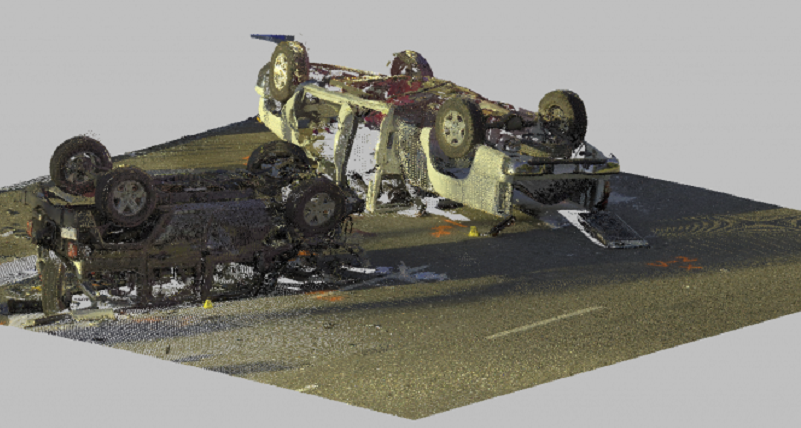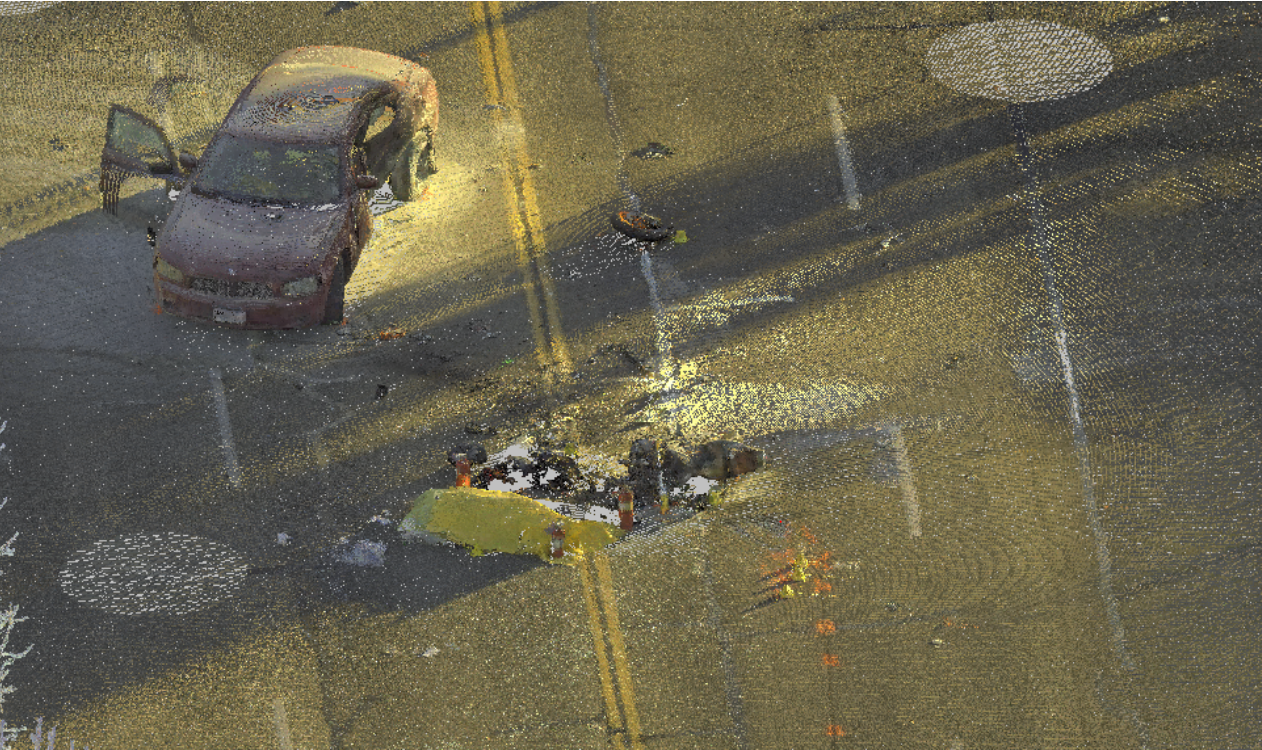Leica Geosystems RTC360 laser scanner satisfies the Santa Ana Police Department collision investigation unit's need for speed

When your crime scene is situated in the middle of a busy intersection in one of metro Los Angeles’s most densely populated cities, you need to get what you need and get out. “It can get pretty dicey out there,” says Investigator Weston Hadley, of the Santa Ana Police Department’s Collision Investigations Unit.
Until recently, Hadley and his fellow investigators had been using a theodolite for their forensic mapping. “A theodolite can make very accurate measurements. The limitation is that it only is taking data points and measurements for items that you choose, and that process can be pretty time consuming,” he says. “We were shutting down major intersections for four, five hours at times to take 200 to 400 data points.”
Like many public safety agencies, they held onto the obsolete device because there was no money in the budget to purchase faster technology.
"The quicker we can get what we need and get out of that road and that right-of-way, the better.”
Today, the Santa Ana Police Department is mapping at record speeds thanks to Precision Survey Supply and a technology lease that made it possible to upgrade to the latest state-of-the-art reality capture solution. Their brand-new Leica RTC360 laser scanner is capturing the entire scene—billions of highly accurate data points—in less than 30 minutes. The new laser scanner also pre-registers the point cloud data in the field automatically, which makes it easy to use and saves even more time back in the office. “It’s such a significant increase in our efficiency,” Hadley says. And with fatal collisions occurring on a regular basis, efficiency is important. “It just doesn’t quit here in Santa Ana,” Hadley says. “We’ve had our Leica RTC360 since the end of December and we have already mapped our 12th collision scene.” Hadley says the RTC360 was an obvious choice. After seeing it in action, it’s also become apparent that the fast, agile and precise 3D reality capture solution is paying off in more ways than one. “We immediately saw the value in how it collects data and the speed,” Hadley says. “But the cost savings and benefits go beyond that in so many ways.”
Better use of officer resources
The RTC360 frees up patrol officers to respond to calls for service in a more timely manner. “We’re a busy city, and when something goes down, especially in daylight and early evening hours, pulling five or six officers to block traffic puts an enormous strain on the resources we have available to handle calls for service. We’re still going to get to those priority calls, but anything less than a priority is going to pend, and those patrol officers are going to sit for five, six hours until we finish the scene,” Hadley says. With the RTC360 mapping an entire scene in less than 30 minutes, that strain on personnel has been alleviated. “The RTC360 provides a better service for the community because we can put our resources to better use than blocking roadways,” he says.
Opens roadways quicker for commuters
The RTC360 frees up patrol officers to respond to calls for service in a more timely manner. “We’re a busy city, and when something goes down, especially in daylight and early evening hours, pulling five or six officers to block traffic puts an enormous strain on the resources we have available to handle calls for service. We’re still going to get to those priority calls, but anything less than a priority is going to pend, and those patrol officers are going to sit for five, six hours until we finish the scene,” Hadley says. With the RTC360 mapping an entire scene in less than 30 minutes, that strain on personnel has been alleviated. “The RTC360 provides a better service for the community because we can put our resources to better use than blocking roadways,” he says.
Increases officer safety
The RTC360 increases officer safety by decreasing their time in harm’s way. According to the National Law Enforcement Memorial Fund, of the 50 officers killed in traffic-related incidents in 2018, 14 were struck while outside their vehicles. It’s not unusual for impaired or distracted drivers to plow through active scenes. “I’ve had to run out of the street several times,” Hadley says. “Thankfully, we’ve never had any officers hit. We’ve had our cars hit. We’ve had buildings hit. We’ve had evidence hit. So the quicker we can get what we need and get out of that road and that right-of-way, the better.”
Reduces human oversight and errors
The RTC360 captures anything and everything in its line of sight at 2 million points per second. A theodolite can only take data points for objects the operator chooses. Even collecting an average of 200 to 400 data points, it was impossible to get everything. “Sometimes, we get distracted or it’s just such a big complicated scene that we can just overlook one piece of evidence,” Hadley says. He remembers one case where, after returning to the office, Hadley discovered the theodolite had malfunctioned. “It was an in-custody fatal DUI with a prior, so this guy’s looking at a murder charge,” he explains. “We had to go out two more times and re-setup right where I initially placed the device.” The first time, he placed the theodolite in the most efficient spot for gathering all the data. “It wasn’t the most efficient when I had to go back and try to shut down lanes. It was really in a bad spot,” he says. “That was a real pain.” With the RTC360, Hadley can now walk away—after just minutes on scene—confident that the scanner captured everything with millimeter accuracy. “And I’m certain I’m not going to be making any trips back out to collision scenes,” he says.
Increaser jurors' decicision-making ability
The RTC360 and its companion scene reconstruction software empowers jurors to make better informed decisions. Previously, evidence mapped by theodolite was presented to the court as two-dimensional illustrations. But by overlaying millions of data points with high dynamic range (HDR) photography, along with geotagged photos and notes, the RTC360 provides an immersive 360-degree, 3D experience. And the data is admissible as scientific evidence. “Now we can really bring someone into the scene as we saw it that day in a way that a two-dimensional drawing could never anywhere approach,” Hadley says. “You can talk about two cars colliding at 40 miles an hour. In concept, they really don’t know what it looks like when a violent collision occurs—the crushed vehicles, the debris field—it can be overwhelming.” When their laser scanned cases reach court, jurors will no longer have to draw on their imaginations. “I think that it’ll have a bigger impact when they can see with their own eyes what we saw—the violence of what occurred and the energy and all of those things,” he says.

Levels the playing field with private industry
It can also undermine the ability to identify inaccuracies or mischaracterizations presented by private experts. “It could put us at a disadvantage if we’re not aware of the current technology’s limitations or nuances,” he says. “If we’re using current technology, at least gives us a starting point to say, ‘That is right’ or ‘That doesn’t look right.’ Whereas if we don’t have any experience in that technology, we basically can’t say anything. Whatever they say is.” Documenting the scene with the RTC360 keeps the agency at the forefront of mapping technology and upholds their credibility in court.
Closing the technology gap
Thanks to their new RTC360, the Collision Investigations Unit has closed its technology gap. Today, the Santa Ana Police Department is now at the leading edge of laser scanning technology and mapping at record speeds. “The Leica RTC360 makes us more efficient in so many ways,” Hadley says. “I think if you really draw back and look at the proverbial forest, you just go, ‘Wow! Why haven’t we been doing this for a long time?’
To learn more about 3D laser scanning and explore scene documentation solutions for your agency, please contact us.



























